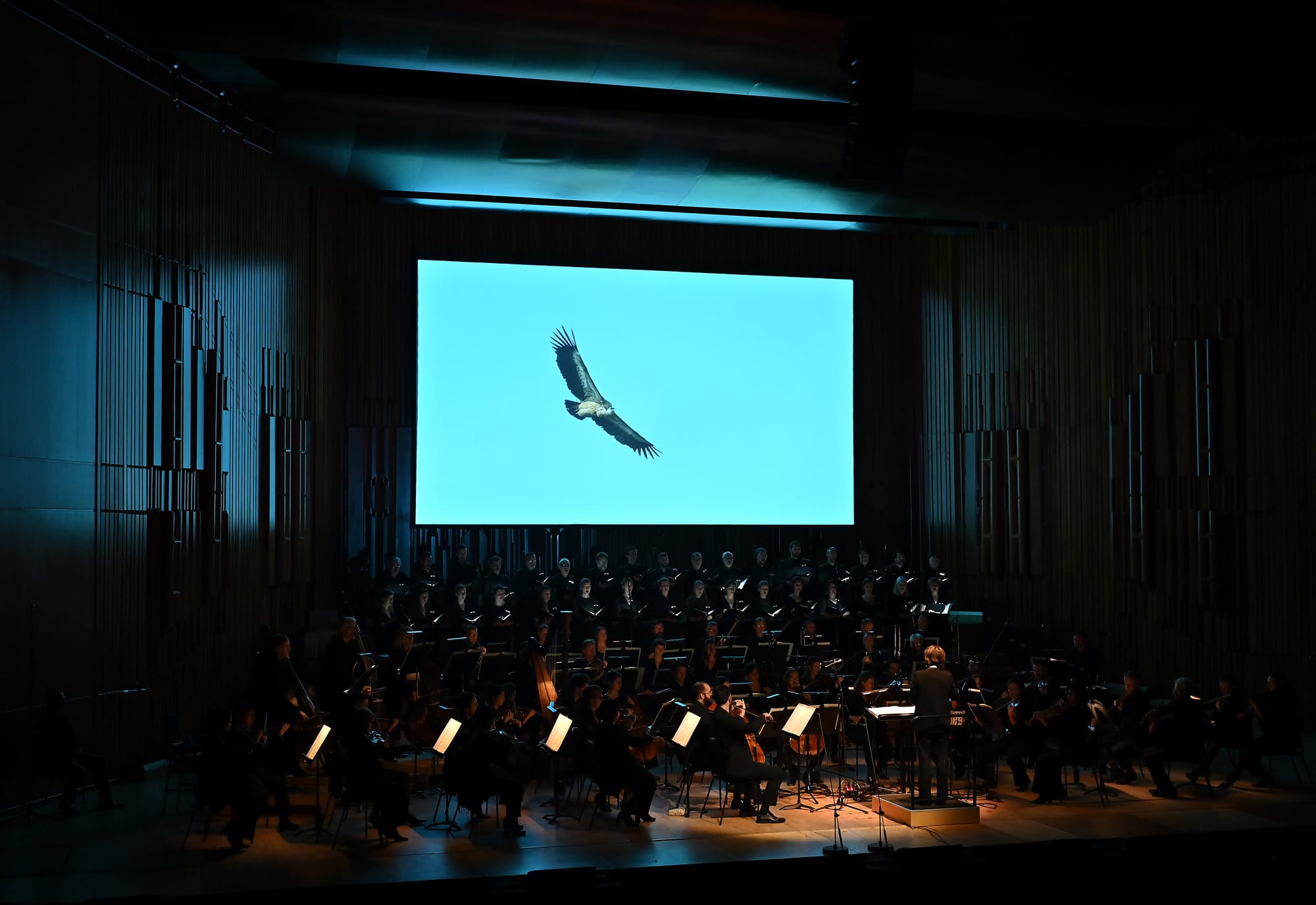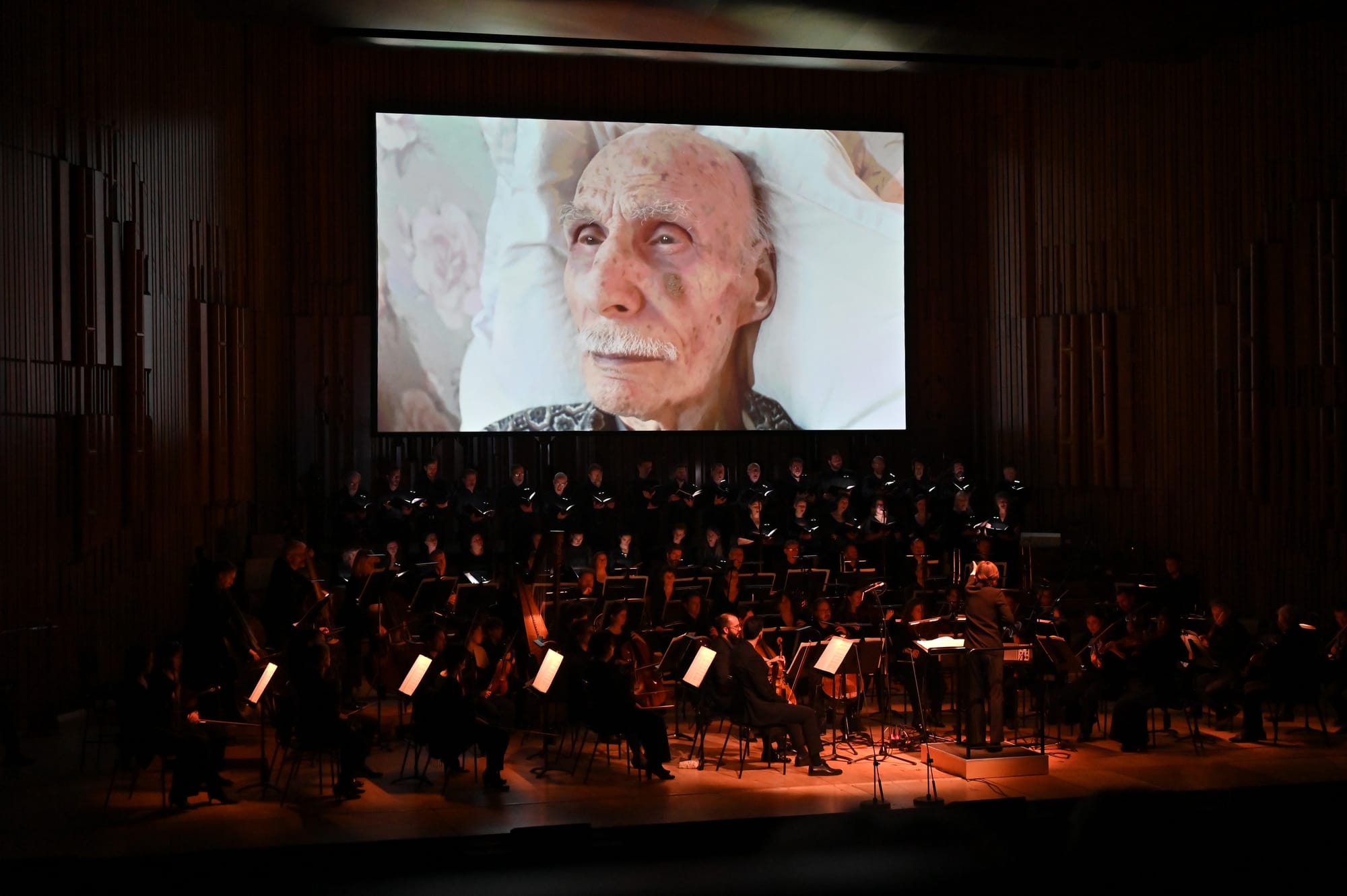Revisiting death: Sky Burial at the Barbican

SKY BURIAL Gounod, Fauré Oliver Barlow (treble); John Brancy (baritone); Amitai Pati (tenor); Mat Collishaw (filmmaker); accentus; Insula Orchestra / Laurence Equilbey (conductor). Barbican Hall, London, 20,11.2023
Gounod – Saint François d’Assise
Fauré – Requiem
The first iteration of this film/concert was in Paris earlier this year at La Seine Musicale, the home of Insula: my review appeared on Seen & Heard International here Mat cluded sippets from interviews with both Laurence Equilbey and Mat CollishawCollishaw’s film is as astounding as it is disturbing. But most of all what Collishaw and Equilbey create together is important: Sky Burial asks us to confront our thoughts about and reactions to death head-on. And that won’t be comfortable for everybody.
The basis of Colishaw’s film, the Tibetan practice of a ‘sky burial’ is explained in full in my review of the February concert. But first, to a visual background of cloudscapes (with light breaking through towards the end), Gounod’s Saint François d'Assise. Written in 1891, the score was only recently discovered (a whole century after composition). The role of Saint Francis is taken by a tenor, here, as in Paris, Amitai Pati Equilbey brings out the pious simplicity of the piece perfectly, and if the performance was not as technically impeccable as her recording on the naïve label (the World Premiere recording), it arguably plumbed the depths of Gounod’s score deeper. Gounod remains criminally undervalued apart from a few select pieces, and this depiction of a saint in his cell and his meditations on life and death is a gem.
The opening of the first movement, ‘La Cellule,’ is cast in E-Minor and marked Moderato sans lentuer. Equilbey paces it brilliantly – there was no sense of dragging or unnecessary solemnity. Insula’s period instruments and low-vibrato style adds extra clarity to Gounod’s writing, emphasising the quasi-ecclesiastical contrapuntal element. That does not mean there is no timbral richness, however - the lower string melody, pure Gounod, that precedes the voice’s entry is the ver epitome of French Romanticism. As in Paris, Amitai Pati was the perfect Saint, his entrance sweet-toned (‘Mon saveur adoré’) yet entirely suited to the text, Pati’s range is perfect in the sense there is no strain or timbral change in the higher reaches, giving his ascent to a tenor top A in his pleas for his God to embrace him a very particular power (‘De ton amour embrase-moi!’). Possibly the greatest moment of beauty was at the words ‘Agneau de Dieu!’ (Lamb of God!). Perhaps the brass (and bassoons) chorale was not quite as perfectly delivered as in the recording, but how powerful this piece is live.
John Brancy took the baritone part, firm and perfectly complementing Pari’s voice (and spatially separated within the stage space). The invitations of ‘Viens! Viens, amant de ma croix!’ (Come, come, lover of my Cross!’) from Brancy were fervent and yet lovely of tone. When the music turns its head metaphorically upwards and hope and Faith delivered appear simultaneously, Equilbey again paced the music supremely well (the marking is now Andante), the phrases ascending, aspirationally, before landing on a place of infinite repose.
The miracle over, Gounod turns to the death of St Francis for Part Two (Gounod simply calls this ’La Mort’). Here, the superb accentus choir plays the part initially of a Chorus of Men (‘Père qui régnez dans les cieux!’; Father who dost reign in the Heavens!) and, later, after Saint Frances’ death, a Chorus of Angels (‘Prends tonvol vers les cieux’; Take flight towards the Heavens). It was a reminder of the sheer excellence o this choir that they blend so well and yet every strand is clearly audible. Saint Francis’ final words are of light dispelling darkness, of a new day dawning (C’est la mort qui s’enfuit!’’ It is death that flees!). Horns depict his failing heartbeat through a broken rhythmic figure (an effect used by Berlioz also, albeit in the strings, in La mort de Cléopâtre). It takes a fine choir indeed to sustain such ethereal quietude in that final chorus, and the sopranos of accentus were simply beautiful.
While my reactions to the Fauré/Collishaw were entirely positive, on second viewing I am tempted to suggest this event nears, and possibly achieves, genius. The rare act of daring – bringing our own mortality full-force in front of us (echoed, perhaps more gently, in campaigns such as Hospice UK’s Dying Matters) - is vital to any human. At a time of maximal fear – recession, war and the suchlike – it seems even more urgent.
Collishaw contrasts a succession of death scenes with images of natural beauty. Flowing water, rivers, represent the stream of life, waterfalls perhaps its abundance. A bird flies against a blue sky, free, almost suspended in its gliding, magnificent. It is, though an instrument o death. Just as a flowing river is part of the world around us, so is the cycle of Nature, of carrion feeding on corpse. The windows of the apartment block double it strikes me, as picture frames – we the spectators enter then exit life endings, voyeurs of grief. Images seem even more potent the second time around, as does Collishaw’s careful use of colour. It is almost not there, everything blanched, except for maybe a pastel counterpane. A dysfunctional vacuum cleaner, useless in present circumstances, reminds us of the daily grind, of the life that will follow, unabated by a departure. Life goes on for those who remain – until, in turn, it doesn’t.
The death scenes are exquisitely observed. Are the people dead? Sometimes, but other times not, and yet the eyes stare, glazed, the moment of death there any moment, the exit well-nigh undetectable (anyone who has watched someone die peacefully will see the film and know how accurate the visuals are).

At the end, we see the bodies transported up a staircase. They will be carrion for the birds. Ashes to ashes, dust to dust, incarnate to food. The soul is gone – bit had it, ask those eyes, departed prior to the last breath.
The performance of Fauré's Requiem wedded to the film was even more remarkable than the Gounod. Equilbey’s harmonic awareness is second to none: witness the shifts in the ‘Sanctus’. Her rhythmic sense allows maximal power to climaxes – there was no rushing whatsoever as the music moved to the ‘Hosanna,’ instead there was the onward trudge – of Death, like in the tarot card’s horse over the bodies, or maybe of a more overarching unstoppable motion towards the enlightenment of the ‘In Paradisium’. Boy treble Oliver Barlow of Trinity Boys Choir offered the plea (‘Pie Jesu’: Merciful Lord Jesus, grant them rest). Barlow’s voice was positively seraphic, and blissfully in tune – not always the case in this movement.
The ‘Libera me’ accompanies the ascent to the roof of the apartment building. Equilbey’s way with this is urgent (seemingly more so than her recording), John Brancy’s delivery of the text around the ‘dreaded day’ of judgements superbly focused. The sheer human fragility of ‘Tremens’ in the choir offered maximal contrast, and yet the prefect emotional reaction to, the impending ‘Dies lrae’. The timpani at the passage before the choir’s statement of the opening melody seemed, as in the Gounod, to represent a human heartbeat. Finally, Paradise arrived, shot full with light, the images of the Earth from space and a starscape mirroring the music’s voyage to the eternal.
We almost missed out on an exquisite encore, the applause almost but not quite finishing before one final bow, and arguably Fauré's most gorgeous piece, the Cantique de Jean Racine, an heavenly unfolding of melody, accentus relishing the blossoming lines (and how a single line suddenly but entirely naturally expands into several). The perfect close to the evening, again at a seemingly perfect tempo, Fauré's music flowing like a radiant, celestial river of light.
A sunning evening, unique, and vitally important.
